Corkscrews by Samuel Cotterill, Edwin Cotterill and B H Harris
Written by Brian May, November 2011
I have a Thomason 3.5 windows corkscrew with a badge I did not recognize (shown below). There is a British coat of arms with a lion and unicorn, around the shield is the motto “HONI SOI QUI MAL Y PENSE” although this can only be partially read and across the bottom the Thomason motto “NE PLUS ULTRA”. Nick Hunt who has a large collection of photographs of Thomason badges identified the badge as being identical, as far as we could tell, to that for B. H. Harris and additionally, very similar to that for Samuel Cotterill.
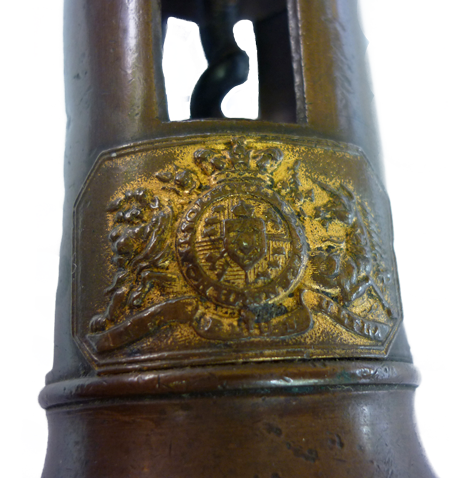
A full barrel Thomason was recently sold on ebay by loxwoodfc (Peter Borrett) with the badge for Saml Cotterill. The badge for this Thomason is below.
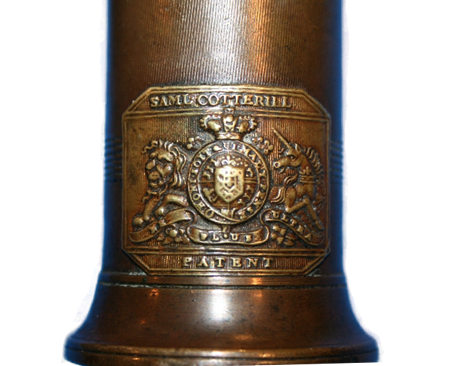
The two badges are almost identical except that on my corkscrew, SAML COTTERILL has been cut off with the window and the bottom word PATENT has also been removed. The only difference noted at high resolution is the absence on my badge of the bunch of flowers (?) on either side of the word PLUS.
Remarkably, the badge on the Samuel Cotterill was as far as we could tell identical to that for B. H. Harris of Birmingham (perhaps very minor differences?????????). I have looked into this further and investigated the lives of Samuel and Edwin Cotterill and B H. Harris.
It will be noted that the window on my corkscrew is more like 0.75 (compare this with the 0.5 window in the Thomason 3.5 windows corkscrew below on the right). Is it possible that my corkscrew was made by son Edwin after his father died in 1840 using his father’s badge but with the name removed through use of a longer window?
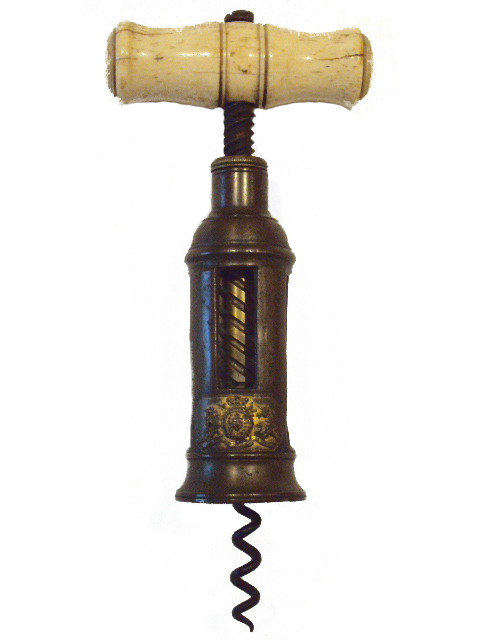
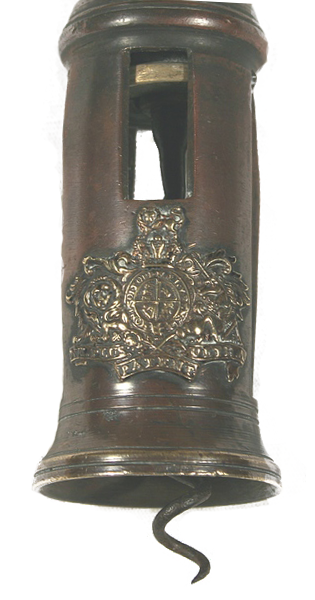
Story of Samuel And Edwin Cotterill
The history of Samuel Cotterill and Edwin Cotterill (the latter of fame to corkscrew collectors because of his wonderful 1842 registered corkscrew) has been researched by Frank and Barbara Ellis and nicely presented in Corkscrews: British Registered Designs. Their story traces the movements of Samuel and Edwin from Wolverhampton to Birmingham. However, there was one issue still not absolutely confirmed –was Samuel really the father of Edwin? All of the evidence suggested this but did not prove it.
The parish registers for St. Peter’s church in Wolverhampton from 1538-1812 (these can be viewed online), revealed the baptism of only one Edwin Cotterill. This Edwin was baptized on 17 November 1806 with father Samuel and mother Lucy. This record is quoted as the baptism of the Edwin Cotterill of interest here. However it was worrying that records consistently placed the baptism of Edwin in the period from 1811-1815 as noted early by Frank and Barbara Ellis. For example in the UK 1861 census in Birmingham, Edwin gave his age as 46 suggesting he was born in 1815. (It should be noted that I also located in the baptism records from St Peter’s Parish the baptism of two sisters of Edwin, Mary Ann born 1802 and Jane born 1804).
To confirm that Edwin’s father was Samuel Cotterill, I obtained the details of Samuel Cotterill’s will from Tony Beck. The will by Samuel was made after the death of wife Lucy in Birmingham in 1838. Importantly in his will, Samuel refers to his son Edwin and daughters Mary Ann, Elisa and Jane. Thus, Samuel is the father of Edwin born in 1806 in Wolverhampton.
So here is a summary of the lives of Samuel Cotterill and son Edwin. (I have added additional information to research done by Frank and Barbara Ellis).
In the 1805-07 and 1809-11 Directories, Sam Cotterhill (sic) is listed as a corkscrew maker trading in Brickkiln Street, Wolverhampton. By 1815, he had moved from Wolverhampton to Birmingham and in the 1815 and 1816-17 Directories, he is a corkscrew maker at Lawrence Street, Birmingham. This interestingly is the time when the 14-year patent taken out by Edward Thomason in 1802 had expired, allowing others such as Samuel to manufacture Thomason corkscrews.
By 1818, Samuel had moved to Duke Street, Birmingham and is listed in Wrightson’s Triennial Directory of Birmingham 1818 as a Cock Screw Mkr, Duke St (see below). A wonderful Freudian slip!

It was of interest to see how many corkscrew makers were specifically listed in this directory in 1818. Here is the alphabetical list:

Five makers only are listed namely, Cope and Cutler at Edmund St and Ann St; Samuel Cotterill; Mary Dowler at Great Charles Street, Edward Parker at Livery St; Isaac Smallwood at Birchall St and Esther Trueman at Weaman St. This list may be under-represented since some makers may not have stipulated corkscrews. For example Edward Thomason is listed as a manufacturer. (James Heeley in Great Charles St is shown as a steel toy manufacturer but as described soon there is no record of him producing corkscrews until about 1837 as James Heeley and Sons). In any event it is probably safe to say that Samuel Cotterill was one of only a few corkscrew makers in 1818 ready to exploit the end of Thomason’s patent period. Certainly of those listed, Cope and Cutler and Dowler were prolific makers of Thomason type corkscrews.
In The Commercial Directory for 1818-19-20 (J Pigot and Co, R& W Dean (Firm) and for the year 1818, Samuel is listed under Birmingham Screw Makers. Also in this list is the corkscrew maker Thomas Dowler (patent and other cork) at Great Charles Street. Thomas may be the son of Mary Dowler mentioned above.
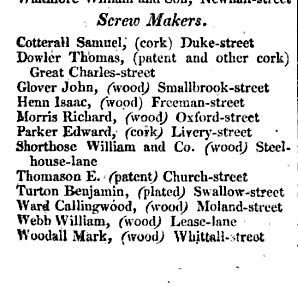
In 1830, Samuel is listed at Duke Street Birmingham under SCREW MAKERS (from The history, topography and directory of Warwickshire by William West in 1830). In the same directory he is also listed under CORKSCREW MAKERS together with Farmer Nehemiah, Hipkins Chas, Jones Rob, Kendrick W, Lee John and Thomason Edw.
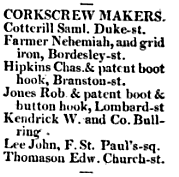
Cope and Cutler now at Jennen’s Row Birmingham, are not listed under corkscrew makers but instead have an impressive advertisement that contains the statement “CORKSCREWS OF EVERY DESCRIPTION”.
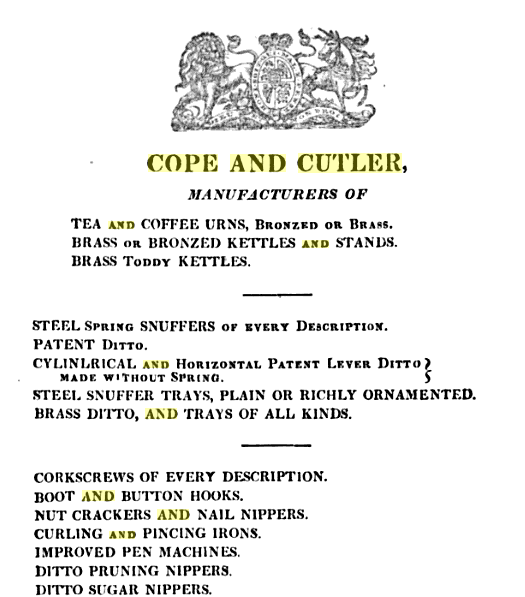
In 1837, Saml Cotterill was still at 10 Duke Street and he is listed in PIGOT AND CO’S NATIONAL COMMERCIAL DIRECTORY OF SCOTLAND AND ISLE OF MAN (with important towns including Birmingham) 1837, under CORK-SCREW MAKERS (patent and boot hook, button hooks, tweezers, stilettos, &c). The use of the word “patent” is misleading, as it also is on the Thomason corkscrew made by Saml Cotterill shown earlier, since Edward Thomason had already patented this invention and there is no suggestion that Samuel obtained a patent for any article. Below is the list of corkscrew makers for 1837.

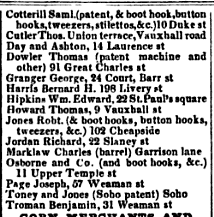
In the above 1837 directory, Samuel Cotterill is also listed as follows:

It is worth noting that James Heeley a well known maker of Thomason type corkscrews was listed earlier in the 1830 directory as a steel toy maker and his son Francis Heeley as a black ornament and gilt toy marker both at Great Charles Street. By 1837, James Heeley and Sons (sons appears to refer to son Francis and the son of Francis, Neville) emerged and were specific manufacturers of corkscrews (see advertisement below for 1837).
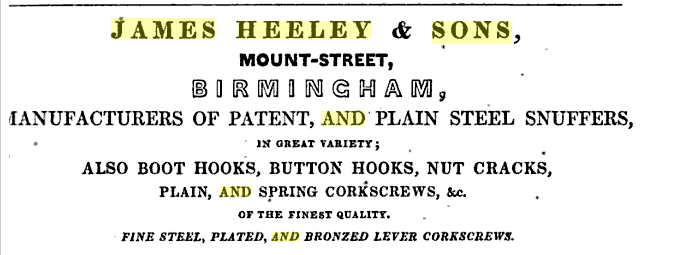
Significantly by 1839 Edwin Cotterill, son of Samuel, is now involved in the production of corkscrews at his father’s business at 10 Duke Street. In Robson’s Birmingham & Sheffield Directory of 1839, there is the entry under “Cork Screw Manfcts” for Cotterill Edwin (Patent), 10 Duke Street. Samuel is now no longer listed possibly due to illness since he died the following year as discussed soon. The complete list of corkscrew manufacturers for 1839 is as follows:
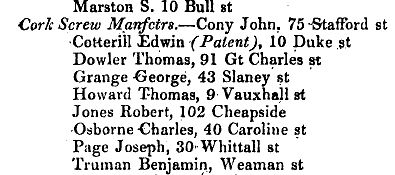
Samuel’s wife Lucy died in 1838 at Anton, Birmingham and Samuel then appears to have revised his earlier will at this time. Under this revised will, Samuel “released to son Edwin all claims and demands on him in respect of Articles of Agreement between them dated 27 Sept 1835”. Presumably this related to passing on the business to Edwin upon his death. All of Samuel’s possessions were to be converted into cash and then paid to his three daughters and son such that all children received an overall equal share of the estate. The trustees of the estate were son Edwin, sons-in-law John Yeomans of Birmingham (druggist) married to Mary Ann, John Barwell of Birmingham (Stamper and Pierce), married to Eliza and John Newey of Birmingham married to Jane.
Samuel died in March 1840 with neither his cause of death nor his age being recorded. On the basis of his children’s ages, it can be surmised he was about 60 years of age.
After his father’s death, Edwin moved from Duke Street to 10 Gosta Green in Birmingham and an advertisement in Pigot’s 1841 Directory shows he was a ”Manufacturer of patent and all kinds corkscrews, champagne nippers, boot and button hooks, horse pickers, nutcrackers, nail nippers, tweezers, key rings &c”. In 1842 he registered his famous corkscrew design “Edwin Cotterill’s Patent Self Adjusting”. The badge on this corkscrew bears no resemblance to that used by his father.
As described in detail by Frank and Barbara Ellis, Edwin’s interests diversified around 1845 and as well as manufacturing corkscrews he began to also manufacture locks and latches etc at new premises, 101 Henry Street. On 25 March 1846, he was granted a patent for “Certain improvements in articles applied to windows, doors and shutters” and this included the Climax Detector Lock his most important invention.
In 1849 (History and General Directory of the Borough of Birmingham by Francis White and Co), the following corkscrew makers are listed:
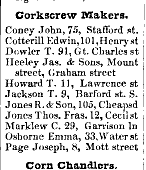
By 1851, Charles Hull at age 24 years was working with Edwin Cotterill in Henry Street and by 1853 Hull had taken over the manufacturing of corkscrews, nut cracks, boot hooks, steel toys etc. Edwin now concentrated on locks and safes and moved to Upper Temple Street.
Edwin married Elizabeth Ellen Hipwood at Handsworth Parish Church County of Stafford on 20 January 1863. Edwin’s occupation was shown as manufacturer and his father as Samuel Cotterill (deceased). Edwin gave his age as 48 and Elizabeth was 31. In fact Edwin was 57 years of age. This difference in ages may have been the reason for him giving a lower age both for the 1861 Census and his marriage.
About 10 years after taking over the business from Edwin, Charles Hull in 1864 patented his famous Royal Club corkscrew. Hull continued with the corkscrew business until about 1880 when it was taken over by Rowland Berkeley who as Berkeley & Co obtained a registered design for a corkscrew in 1892. At the time, Berkeley & Co traded as a steel toy manufacturer and was still situated at 101 Henry Street.
Thus it is an interesting series of events with Samuel Cotterill establishing a foundation corkscrew manufacturing business in Birmingham about 1815, that was taken over in turn by his son Edwin, Charles Hull and Rowland Berkeley over a period of 85 years.
It will also be interesting now to compare the badge on my Thomason 3.5 windows with the badges on other Thomason type or Kings Screw corkscrews made either by Samuel or Edwin. Steven Webb has seen a Kings Screw made by Edwin Cotterill but a photograph of this has not been located as yet.
Sources:
Corkscrews: British Registered Designs by Frank Ellis and Barbara Ellis (2007)
The Lock Collector September/December 2005, Issue No. 9 by Tony Beck
The Lock Collectory January/March 2006, Issue No. 10 by Tony Beck.
Acknowledgements:
Thanks to Tony Beck for his research on Edwin Cotterill, published in The Lock Collector issues.
Story of B H Harris
This is Bernard Hector Harris who was born about 1799 in Birmingham and had his business at 128 Livery Street. In Wrightson’s Triennial Directory of Birmingham 1818, he is shown as a brass founder and button manufacturer at Northwood Street and St Pauls Square. Years later in 1830, he is listed as a brass founder at Mary Ann Street (The history, topography and directory of Warwickshire by William West 1830).
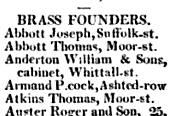

Interestingly, the only record I can locate that specifically identifies him as being a corkscrew maker is in the 1837 PIGOT directory shown earlier where he is located at 198 Livery Street; also listed is Samuel Cotterill as described. In the same directory for 1837, Bernard H Harris is also listed under CASTERS (brass); COCK FOUNDERS, BRUSH MAKERS AND BRASS FOUNDERS. He was also an agent to the Alliance fire and life office at the same address.
Harris does not appear in the list of 1839 cork screw manufacturers shown earlier (Robson’s Birmingham and Sheffield Directory 1839); Edwin Cotterill listed for the first time as mentioned already. (Harris was not listed under Screw Makers). Harris is however listed under cock founders, and described as a brass cock manufacturer and agent at 198 Livery Street.
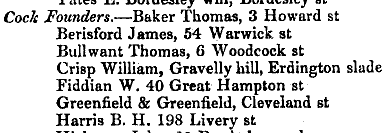

His occupation is shown as a brass founder in the 1841 census and his age as 40 years. He had a wife and three daughters and they lived in Caroline Street.
In 1849 (History and General Directory of the Borough of Birmingham by Francis White and Co), Bernard H Harris is living at 193 Camden Street and working still at 198 Livery Street. He shown as follows:

Ten years later in the 1851 census, he gave his occupation as metal dealer living in Camden Street. He appears to have died in 1858 (he would have been about 58 years of age).

